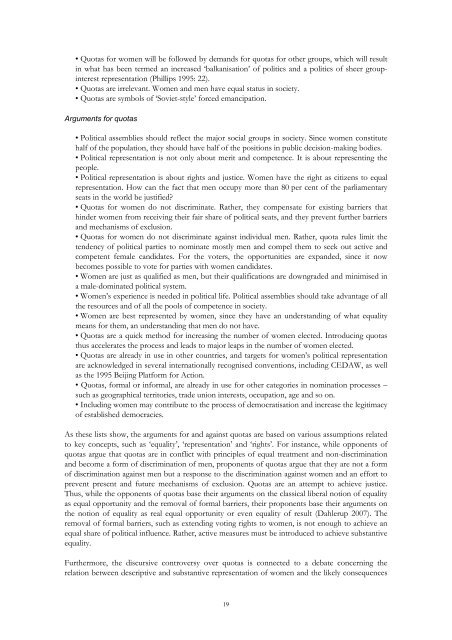support for female c<strong>and</strong>idates has spread across the ideological spectrum, <strong>and</strong> <strong>gender</strong> <strong>quotas</strong> or‘soft <strong>quotas</strong>’ have also been used by parties oriented towards the centre <strong>and</strong> right (Norris 2004: 198;Matl<strong>and</strong> <strong>and</strong> Studlar 1996; Caul 1999).Another aspect that needs to be taken <strong>in</strong>to account is the process of imitation, or contagion.Political scientists Richard Matl<strong>and</strong> <strong>and</strong> Donley T. Studlar (1996) argue that support for <strong>gender</strong><strong>quotas</strong> is diffused across parties due to a process of contagion. Contagion is a process throughwhich dom<strong>in</strong>ant parties are forced to adopt <strong>quotas</strong> by be<strong>in</strong>g seriously challenged by m<strong>in</strong>or parties,usually located to the left of the ideological spectrum. Once one party has <strong>in</strong>troduced a new policy,this triggers a process by which other parties may feel forced to follow suit. By nom<strong>in</strong>at<strong>in</strong>g women,small parties demonstrate that there is no penalty for promot<strong>in</strong>g women, <strong>and</strong> larger parties will feel<strong>in</strong>cl<strong>in</strong>ed to respond to <strong>in</strong>ternal as well as external pressures by actively support<strong>in</strong>g women.Accord<strong>in</strong>g to Matl<strong>and</strong> <strong>and</strong> Studlar, this will clearly be the case for parties that are ideologically closeto the parties <strong>in</strong>itiat<strong>in</strong>g the promotion of women. These parties fear los<strong>in</strong>g voters to the <strong>in</strong>novat<strong>in</strong>gparty. Over time, as each party reacts to an electoral threat from close political competitors, theperceived need to nom<strong>in</strong>ate women will lead to more or less all the parties on the political spectrumcomply<strong>in</strong>g with the new norms <strong>in</strong> order to demonstrate <strong>their</strong> commitment to equal rights, as <strong>in</strong> theNorwegian case. The lack of <strong>gender</strong> <strong>quotas</strong> among the right <strong>and</strong> centre parties <strong>in</strong> Germany,however, shows the limit of this theory. If there is no pressure from the voters – <strong>in</strong> this case fromright or centre voters – to have more women on the lists, then parties may consider <strong>gender</strong>irrelevant <strong>and</strong> will avoid <strong>gender</strong> <strong>quotas</strong>.2. Quotas – a hotly debated issueAt the same time as the <strong>in</strong>troduction of <strong>gender</strong> <strong>quotas</strong> is spread<strong>in</strong>g rapidly across the world <strong>and</strong> israis<strong>in</strong>g hopes for <strong>in</strong>creases <strong>in</strong> women’s political representation, <strong>quotas</strong> are also meet<strong>in</strong>g fierceresistance. Not all women support <strong>quotas</strong>, not even all fem<strong>in</strong>ists; <strong>and</strong> men are also divided on theissue. As the case studies show, op<strong>in</strong>ions vary <strong>in</strong> terms of effects <strong>and</strong> repercussions but alsoconcern<strong>in</strong>g the mean<strong>in</strong>g of key concepts <strong>in</strong> political analysis, such as ‘equality’, ‘representation’ <strong>and</strong>‘rights’.2.1. Arguments for <strong>and</strong> aga<strong>in</strong>st <strong>quotas</strong>Some of the most common arguments for <strong>and</strong> aga<strong>in</strong>st <strong>quotas</strong> are listed below.Arguments aga<strong>in</strong>st <strong>quotas</strong>• Political representation is about the representation of ideas <strong>and</strong> <strong>in</strong>terests, not about <strong>gender</strong> orthe representation of social groups.• Political representation is a question of merit – let the best c<strong>and</strong>idate for the job w<strong>in</strong>!• Quotas go aga<strong>in</strong>st the pr<strong>in</strong>ciple of equal opportunity for all <strong>and</strong> the pr<strong>in</strong>ciple of equaltreatment, s<strong>in</strong>ce one group is given priority.• Quotas are discrim<strong>in</strong>atory, s<strong>in</strong>ce one group of c<strong>and</strong>idates will be favoured at the expense ofbetter-qualified c<strong>and</strong>idates who are set aside. Thus, <strong>quotas</strong> represent reverse discrim<strong>in</strong>ation,where better-qualified men will lose out <strong>in</strong> order to achieve a quota for women.• Quotas are <strong>in</strong> conflict with the pr<strong>in</strong>ciple of local autonomy, s<strong>in</strong>ce the prerogative of partyorganisations to decide over <strong>their</strong> own c<strong>and</strong>idate selection processes is restricted.• Quotas are undemocratic, s<strong>in</strong>ce voters should have the f<strong>in</strong>al say on who is to represent them.• Many women do not want to hold office. If they did, <strong>their</strong> numbers <strong>in</strong> politics would <strong>in</strong>crease.• Many women do not want to be elected just because they are women. Quotas contribute to asuspicion that women have been promoted thanks to <strong>their</strong> sex rather than <strong>their</strong> talent.18
• Quotas for women will be followed by dem<strong>and</strong>s for <strong>quotas</strong> for other groups, which will result<strong>in</strong> what has been termed an <strong>in</strong>creased ‘balkanisation’ of politics <strong>and</strong> a politics of sheer group<strong>in</strong>terestrepresentation (Phillips 1995: 22).• Quotas are irrelevant. Women <strong>and</strong> men have equal status <strong>in</strong> society.• Quotas are symbols of ‘Soviet-style’ forced emancipation.Arguments for <strong>quotas</strong>• Political assemblies should reflect the major social groups <strong>in</strong> society. S<strong>in</strong>ce women constitutehalf of the population, they should have half of the positions <strong>in</strong> public decision-mak<strong>in</strong>g bodies.• Political representation is not only about merit <strong>and</strong> competence. It is about represent<strong>in</strong>g thepeople.• Political representation is about rights <strong>and</strong> justice. Women have the right as citizens to equalrepresentation. How can the fact that men occupy more than 80 per cent of the parliamentaryseats <strong>in</strong> the world be justified?• Quotas for women do not discrim<strong>in</strong>ate. Rather, they compensate for exist<strong>in</strong>g barriers thath<strong>in</strong>der women from receiv<strong>in</strong>g <strong>their</strong> fair share of political seats, <strong>and</strong> they prevent further barriers<strong>and</strong> mechanisms of exclusion.• Quotas for women do not discrim<strong>in</strong>ate aga<strong>in</strong>st <strong>in</strong>dividual men. Rather, quota rules limit thetendency of political parties to nom<strong>in</strong>ate mostly men <strong>and</strong> compel them to seek out active <strong>and</strong>competent female c<strong>and</strong>idates. For the voters, the opportunities are exp<strong>and</strong>ed, s<strong>in</strong>ce it nowbecomes possible to vote for parties with women c<strong>and</strong>idates.• Women are just as qualified as men, but <strong>their</strong> qualifications are downgraded <strong>and</strong> m<strong>in</strong>imised <strong>in</strong>a male-dom<strong>in</strong>ated political system.• Women’s experience is needed <strong>in</strong> political life. Political assemblies should take advantage of allthe resources <strong>and</strong> of all the pools of competence <strong>in</strong> society.• Women are best represented by women, s<strong>in</strong>ce they have an underst<strong>and</strong><strong>in</strong>g of what equalitymeans for them, an underst<strong>and</strong><strong>in</strong>g that men do not have.• Quotas are a quick method for <strong>in</strong>creas<strong>in</strong>g the number of women elected. Introduc<strong>in</strong>g <strong>quotas</strong>thus accelerates the process <strong>and</strong> leads to major leaps <strong>in</strong> the number of women elected.• Quotas are already <strong>in</strong> use <strong>in</strong> other countries, <strong>and</strong> targets for women’s political representationare acknowledged <strong>in</strong> several <strong>in</strong>ternationally recognised conventions, <strong>in</strong>clud<strong>in</strong>g CEDAW, as wellas the 1995 Beij<strong>in</strong>g Platform for Action.• Quotas, formal or <strong>in</strong>formal, are already <strong>in</strong> use for other categories <strong>in</strong> nom<strong>in</strong>ation processes –such as geographical territories, trade union <strong>in</strong>terests, occupation, age <strong>and</strong> so on.• Includ<strong>in</strong>g women may contribute to the process of democratisation <strong>and</strong> <strong>in</strong>crease the legitimacyof established democracies.As these lists show, the arguments for <strong>and</strong> aga<strong>in</strong>st <strong>quotas</strong> are based on various assumptions relatedto key concepts, such as ‘equality’, ‘representation’ <strong>and</strong> ‘rights’. For <strong>in</strong>stance, while opponents of<strong>quotas</strong> argue that <strong>quotas</strong> are <strong>in</strong> conflict with pr<strong>in</strong>ciples of equal treatment <strong>and</strong> non-discrim<strong>in</strong>ation<strong>and</strong> become a form of discrim<strong>in</strong>ation of men, proponents of <strong>quotas</strong> argue that they are not a formof discrim<strong>in</strong>ation aga<strong>in</strong>st men but a response to the discrim<strong>in</strong>ation aga<strong>in</strong>st women <strong>and</strong> an effort toprevent present <strong>and</strong> future mechanisms of exclusion. Quotas are an attempt to achieve justice.Thus, while the opponents of <strong>quotas</strong> base <strong>their</strong> arguments on the classical liberal notion of equalityas equal opportunity <strong>and</strong> the removal of formal barriers, <strong>their</strong> proponents base <strong>their</strong> arguments onthe notion of equality as real equal opportunity or even equality of result (Dahlerup 2007). Theremoval of formal barriers, such as extend<strong>in</strong>g vot<strong>in</strong>g rights to women, is not enough to achieve anequal share of political <strong>in</strong>fluence. Rather, active measures must be <strong>in</strong>troduced to achieve substantiveequality.Furthermore, the discursive controversy over <strong>quotas</strong> is connected to a debate concern<strong>in</strong>g therelation between descriptive <strong>and</strong> substantive representation of women <strong>and</strong> the likely consequences19
- Page 3 and 4: Directorate-General Internal Polici
- Page 5 and 6: Electoral Gender Quota Systems andT
- Page 8 and 9: AppendicesThe methodology of the qu
- Page 10 and 11: Table 41. Women’s representation
- Page 12 and 13: 1. Mapping of electoral gender quot
- Page 14 and 15: Committee of Ministers’ Recommend
- Page 16 and 17: have occurred after election day -
- Page 18 and 19: parties and take the form of intern
- Page 20 and 21: Knowledge of different electoral qu
- Page 24 and 25: of more women in politics. Many opp
- Page 26 and 27: Figure 3. The incremental track mod
- Page 28 and 29: is probably that gender quotas rema
- Page 30 and 31: to gender quotas. Likewise, the dat
- Page 32 and 33: ‘Special organisation for women w
- Page 34 and 35: individual parties that adopt them,
- Page 36 and 37: political party in the Swedish Parl
- Page 38 and 39: then the requirement of 50 per cent
- Page 40 and 41: proportion of women elected in the
- Page 42 and 43: and organisation of women are cruci
- Page 44 and 45: Matland, Richard E., ‘Enhancing W
- Page 46 and 47: Case studyBelgium: a best practice
- Page 48 and 49: While the 1994 act applied to all e
- Page 50 and 51: need to include at least one woman,
- Page 52 and 53: introduced, individual parties adop
- Page 54 and 55: Marissal, Claudie and Hansen, Ingri
- Page 56 and 57: In order to correct the discriminat
- Page 58 and 59: The legal vacuum pertaining to the
- Page 60 and 61: y women in terms of number of seats
- Page 62 and 63: 5. ‘Virtuous dynamic’: the symb
- Page 64 and 65: Case studyGermany: successful quota
- Page 66 and 67: party positions (Gruppenwahlen zu P
- Page 68 and 69: districts, quota rules are often no
- Page 70 and 71: Table 14. Success rates of female a
- Page 72 and 73:
Figure 5. Development of the percen
- Page 74 and 75:
so far no formal rules have been ad
- Page 76 and 77:
Case studyPoland: one step forward,
- Page 78 and 79:
16 in Poland)Rady powiatów(second
- Page 80 and 81:
3. Evaluation3.1. Candidate lists i
- Page 82 and 83:
List, in Ozorków Women of Tomorrow
- Page 84 and 85:
3.4. Representation of women in oth
- Page 86 and 87:
Case studySlovenia: from voluntary
- Page 88 and 89:
council. The positions of candidate
- Page 90 and 91:
3.2.2. The introduction of legislat
- Page 92 and 93:
Table 25 shows that only one of the
- Page 94 and 95:
Source: Author’s own calculation
- Page 96 and 97:
Zakon o volitvah v Evropski parlame
- Page 98 and 99:
Advocates for quotas for women lobb
- Page 100 and 101:
Table 31. The percentage and number
- Page 102 and 103:
Table 33. Municipality elections in
- Page 104 and 105:
Case studySweden: small steps, big
- Page 106 and 107:
40 per cent of either sex on the pa
- Page 108 and 109:
voluntary party quotas than in part
- Page 110 and 111:
The zipper system (50 per cent) int
- Page 112 and 113:
While quotas for minority groups ha
- Page 114 and 115:
Case studyThe United Kingdom: polit
- Page 116 and 117:
In contrast to Labour, the Scottish
- Page 118 and 119:
The twinning and zipping policies a
- Page 120 and 121:
differences across the political pa
- Page 122 and 123:
Appendix IThe methodology of the qu
- Page 124 and 125:
Brigitte Geissel is a political sci
- Page 126:
ZLSDZZPUnited List of Social Democr






